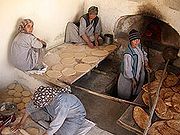- Roti Naan
-
Nan (devanagari: नान, nān; Urdu/Persisch: نان; Englisch auch Naan, Turksprachen Zentralasiens: Nan) ist eine Brotsorte, die in Südasien (Indien, Pakistan, Bangladesch) und Zentralasien (Afghanistan, Usbekistan, Tadschikistan) sowie im vorderen Orient (Iran) meist als Beilage zu heißen Speisen gegessen wird. Nan hat eine flache, fladenartige Form, die man vor dem Backen etwas in die Länge zieht. Der innere Teil ist flach, während der äußere Rand etwas dicker bleibt. Es ähnelt so einem Pizza-Boden.
Im Gegensatz zu anderen indischen Brotsorten stellt man Nan aus gesäuertem Teig her, etwa durch Hinzufügen von Joghurt, sowie mit Hilfe von Hefe oder ersatzweise mit Backpulver. Ursprünglich waren die Grundzutaten Hirse und Hefe, heute backt man oft mit Weizenmehl. Nan-Brote werden über offener Glut gebacken. Von dieser natürlichen Backweise, die besonders viel Sorgfalt erfordert, stammt auch der typische Geschmack.
Heutzutage ist Nan-Brot auch über die Grenzen Indiens hinaus bekannt und vorgebacken in vielen Supermärkten erhältlich.
Ursprung
Das Wort Nan stammt ursprünglich aus den Ländern mit persischer Sprache (Iran, Afghanistan, Tadschikistan) und bedeutet einfach "Brot". Der Name verbreitete sich später in den Nachbarsprachen auf dem indischen Subkontinent und bei den Turkvölkern Zentralasiens.
Weblinks
Wikimedia Foundation.


